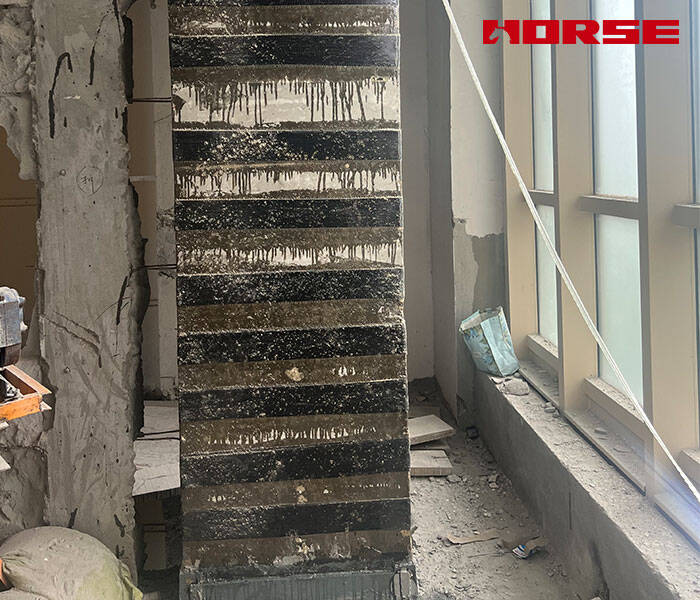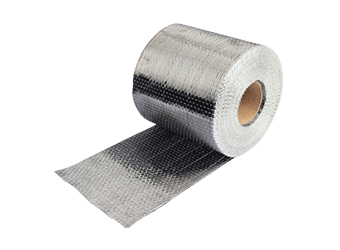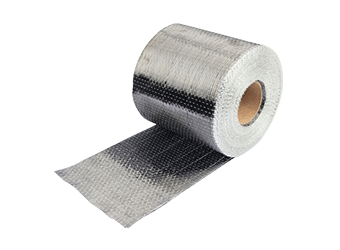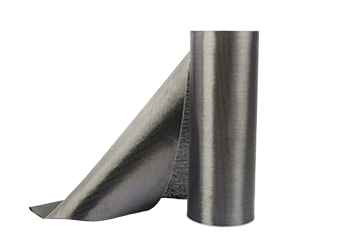Solutions
Horse Construction offers full range of structural strengthening materials with technical supports, documentation supports, products supports, project supports.
How To Apply Carbon Fiber To Strengthen Columns With Different Stress Types?

The maximization of the effect of carbon fiber reinforced columns is essentially to accurately match the high tensile performance of carbon fibers with the stress characteristics of the columns. The core logic, reinforcement form, and key parameters of different stress types vary significantly, as follows:
1、 Axial compression column (only bearing vertical pressure, without eccentric bending moment)
Core logic
By utilizing the circumferential confinement effect of carbon fiber cloth, the concrete in the core area is compressed like a "steel hoop", limiting its lateral expansion (concrete is prone to transverse cracking and failure under compression), thereby significantly improving the compressive bearing capacity and ductility of concrete (avoiding brittle failure).
Detailed reinforcement plan
Reinforcement form: Only "circumferential carbon fiber cloth wrapping" is required, without longitudinal bonding (no additional bending moment needs to be borne longitudinally).
Priority should be given to using unidirectional carbon fiber cloth (with higher tensile strength), adopting the form of "full wrapping+interval winding" or "continuous full wrapping", with the latter having better restraint effect.
Key parameter control
Fabric width selection: Rectangular columns are preferred to use 200-300mm wide fabric, while circular columns are preferred to use 300-500mm wide fabric to avoid excessive seams affecting overall integrity.
Winding spacing: When winding at intervals, the circumferential tape spacing should be ≤ 200mm; if higher bearing capacity is required, continuous full wrapping (spacing=0) should be used, with a lap length of ≥ 100mm (and not less than 1/2 of the fabric width).
Package scope: It needs to cover the entire height of the column. If there are beam or slab constraints at the upper and lower ends of the column, it needs to be extended to 50-100mm inside the beam or slab to form an "effective constraint area".
Special precautions
The corners of rectangular columns must be treated with circular arcs (radius ≥ 20mm) and repaired with epoxy mortar to avoid the carbon fiber cloth from being subjected to concentrated stress and breaking at the corners.
If the axial compression ratio of the column is too high (≥ 0.9), longitudinal steel bars (or additional steel sections) need to be implanted in the column first, and then combined with circumferential carbon fiber cloth. Carbon fiber alone cannot meet the reinforcement requirements.
2、 Eccentric compression column (bearing vertical pressure+bending moment, such as frame column, side column)
Core logic
The collaborative work of "longitudinal bending moment resistance+circumferential expansion resistance" is required: the longitudinal carbon fiber cloth bears part of the bending moment (replacing or assisting the steel reinforcement in tension), and the circumferential carbon fiber cloth restrains the core concrete (improving compressive strength), jointly resisting the combined effect of "compression+bending".
Reinforcement form:
The combination system of "longitudinal carbon fiber cloth+circumferential carbon fiber belt" must be used, and neither is indispensable.
Longitudinal cloth: pasted on the tensile side of the column (under bending moment, one side is in tension and the other side is in compression), with the quantity determined by the bending moment calculation, usually 2-4 layers.
Circumferential tape: Wrapped on the outer side of the longitudinal fabric with a spacing of ≤ 150mm, it not only constrains the core concrete but also prevents the longitudinal fabric from peeling off under tension.
Key parameter control
Longitudinal cloth: The length should cover the entire height of the column, and both ends should extend 100-150mm into the beam or slab (anchorage); Match the width of the fabric with the width of the circumferential belt (such as a longitudinal fabric width of 200mm and a circumferential belt width of 150mm) to avoid overlapping seams.
Circumferential belt: In the "effective tension zone" of the longitudinal fabric (within the height range of the middle 1/3 of the column), it is necessary to increase the winding density (spacing ≤ 100mm). The bending moment effect is most significant in this area, and the core concrete is prone to cracking.
Pasting sequence: First, apply the longitudinal cloth (ensuring precise positioning and consistency with the tension direction). After the longitudinal cloth adhesive has cured (about 24 hours), then apply the circumferential tape, which should be tightly attached to the longitudinal cloth without gaps.
Special precautions
If there is a bidirectional eccentric bending moment in the column (such as a corner column), longitudinal cloth should be pasted in both vertical directions to form a "cross shaped" longitudinal system, and the circumferential band should be fully wrapped to ensure that all directions are constrained.
When pasting vertically, it is necessary to use a "positioning fixture" to fix it, in order to avoid positional deviation caused by adhesive flow and affect the bending moment resistance effect.
3、 Compression bending shear column (bearing vertical pressure+bending moment+shear force, such as bottom frame columns and seismic zone columns)
Core logic
On the basis of "longitudinal bending moment resistance+circumferential expansion resistance", "carbon fiber U-shaped hoop or closed hoop shear resistance" is added to utilize the shear performance of carbon fiber to resist the shear failure of columns (shear failure is more sudden than bending failure and needs to be prioritized for prevention and control).
Detailed reinforcement plan
Reinforcement form: combination of "longitudinal carbon fiber cloth (bending resistance)+circumferential carbon fiber closure hoop (compression resistance+shear resistance)", or "longitudinal cloth+carbon fiber U-shaped hoop (attached to the side of the column, anchored into the beam at both ends)".
Shear resistance key: The spacing between circumferential closure hoops should be determined based on shear force calculation, usually ≤ 100mm, and should be increased to ≤ 50mm at the upper and lower ends of the column (beam column node area) (concentrated shear force in the node area).
Key parameter control
U-shaped hoop: anchoring length ≥ 300mm (implanted in the beam). If the beam section is small, "mechanical anchoring" (such as drilling holes and inserting bolts to fix the end of the U-shaped hoop) should be used to prevent anchoring failure.
Overall collaboration:The adhesive for the longitudinal fabric, circumferential hoop, and U-shaped hoop must be of the same brand (to avoid compatibility issues), and when pasting, it is necessary to ensure that there are no bubbles between each layer, forming a "whole stress shell"
You can find anything here you are in need of, have a trust trying on these products, you will find the big difference after that.

High strength, unidirectional carbon fiber wrap pre-saturated to form a carbon fiber reinforced polymer (CFRP) wrap used to strengthen structural concrete elements.

High strength unidirectional carbon fiber fabric for concrete repair and structural strengthening

High strength unidirectional carbon fiber fabric for concrete repair and structural strengthening